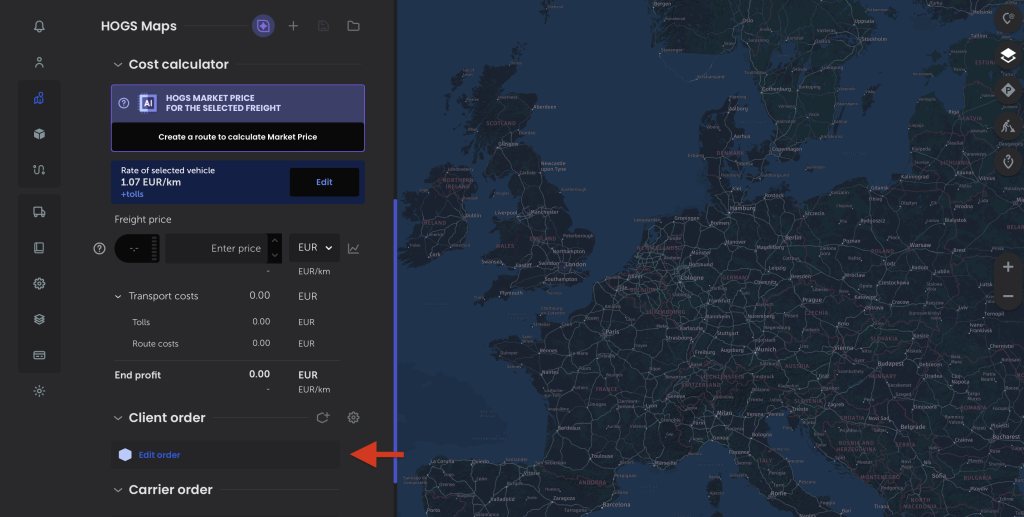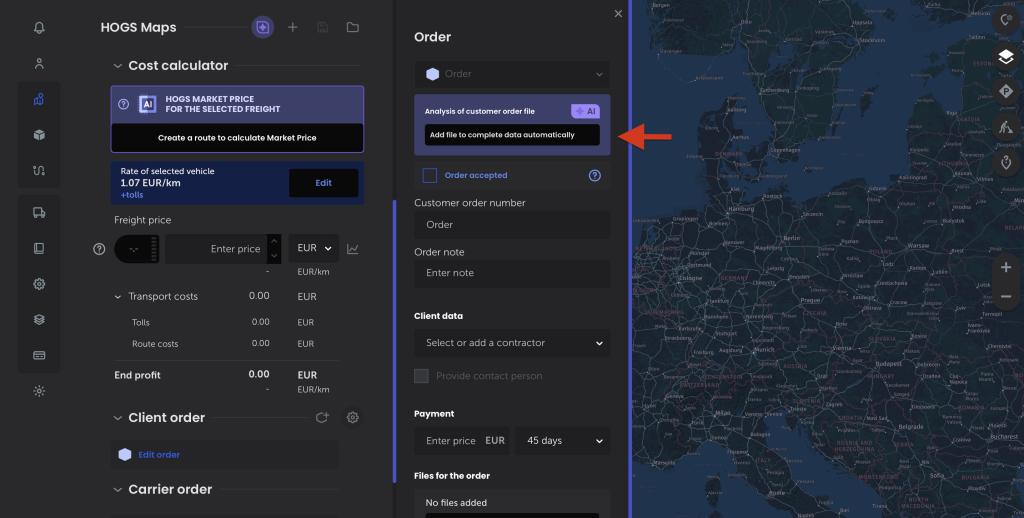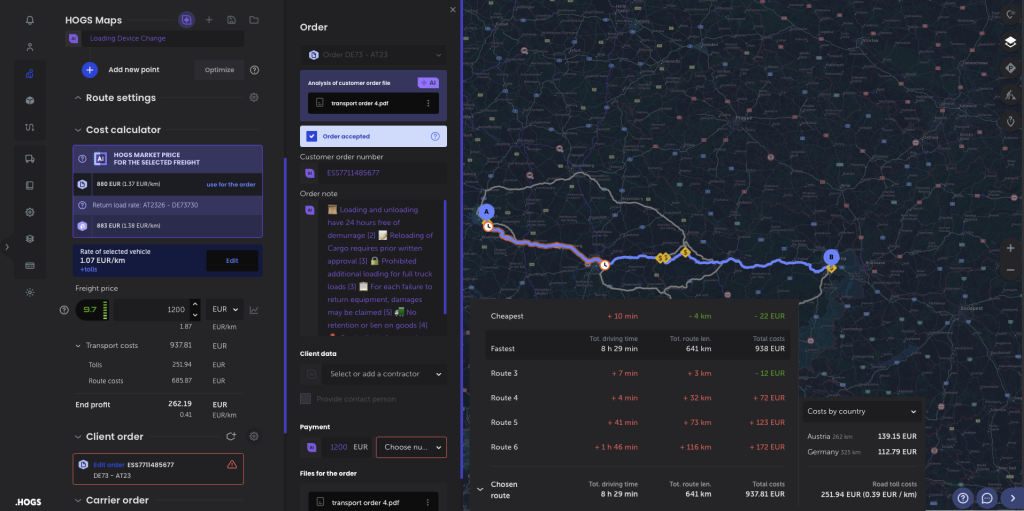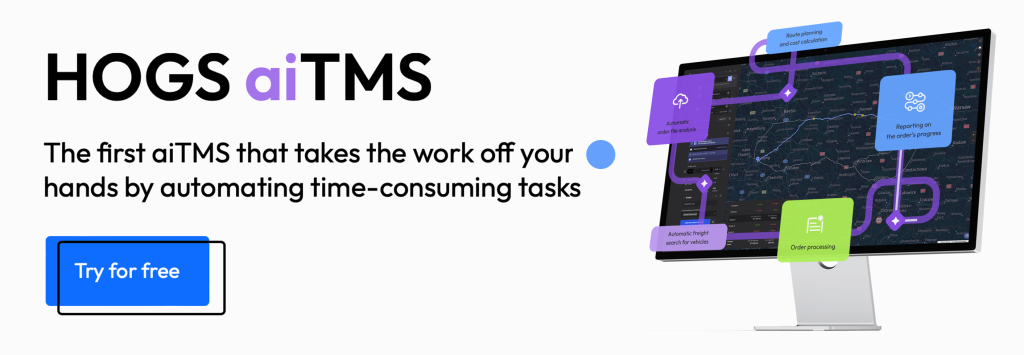What is TMS? 7 benefits of a Transportation Management System
21 February '25
Reading time 10 minutes
In today’s world, transport management has become a key element of success for any company operating in the logistics industry. With increasing competition and evolving customer expectations, businesses must demonstrate flexibility and innovation.
A Transportation Management System (TMS) is a tool that can significantly streamline this process, enabling efficient planning, monitoring, and analysis of transport operations. In this article, we will explore what TMS is, the benefits of its implementation, and how to effectively utilize it in the daily operations of transport companies. We will also explain why modern technologies transforming TMS systems are a game-changer in this industry.
Are you ready to discover how TMS can revolutionize your approach to logistics? Keep reading!
Table of contents
What is TMS, or a transportation management system?
7 benefits of implementing a TMS
aiTMS by HOGS – the tool of the future
What is TMS? – Transportation management system

A Transportation Management System (TMS) is software that helps companies manage, optimize, and automate transport processes and tasks related to order fulfillment.
With a TMS, many tasks related to planning, monitoring, and analyzing transport operations can be automated, leading to significant cost savings and improved operational efficiency. This means fewer empty runs, fewer delays, and faster freight settlements.
Definition of a Transportation Management System
TMS is a tool that enables comprehensive transport logistics management. It covers all stages of the delivery process—from planning and organizing transport, through shipment tracking, to analyzing results and settling orders.
By implementing a TMS, businesses can respond more effectively to market changes and adjust their operations to meet customer demands.
Why is a Transportation Management System important?
In today’s world, where competition is fierce and customer expectations are constantly growing, a TMS has become an essential tool for any transport company. Using a TMS increases transparency in logistics processes, leading to better decision-making.
It’s also crucial to stay up to date with the latest technological advancements in transport management, as this field is evolving rapidly. The newest tools minimize time spent on tedious tasks required by traditional systems and further optimize order execution. We will explore this topic further in the next sections of this article.
7 benefits of implementing a Transportation Management System
Implementing a Transportation Management System (TMS) brings numerous benefits that enhance operational efficiency and improve customer service quality. A TMS not only automates routine tasks but also provides better control over costs and delivery times.
In this section, we will explore the key benefits of adopting a TMS, which can significantly impact the growth and competitiveness of your company. Here are the seven most important advantages to consider when deciding to implement such a system.
1. Cost optimization

A Transportation Management System (TMS) enables a detailed analysis of transport costs, identifying areas where savings can be made. The ability to compare transport rates, plan routes, and assess their efficiency allows companies to manage expenses better and streamline daily operations.
Additionally, analyzing historical data enables forecasting future costs and making more informed financial decisions. This directly reduces administrative expenses for both logistics service providers and end customers.
2. Significant time savings

One of the key advantages of a TMS is its ability to quickly plan and monitor transport operations. With automated reminders and real-time updates, companies can better manage delivery schedules.
TMS solutions also allow for flexible responses to unexpected events such as delays or route changes, directly improving punctuality across the entire supply chain.
The most significant time savings come from integrating with freight exchanges. This functionality allows you to find the most suitable loads with the shortest possible empty mileage, increasing overall efficiency.
HOGS aiTMS – takes the work off your hands by eliminating time-consuming tasks!
3. Better customer service & customer satisfaction with TMS

Using a TMS improves customer service quality. With better shipment visibility, customers can stay informed about their orders in real-time, increasing their satisfaction.
Providing accurate delivery time estimates and quickly resolving shipping issues builds trust among clients—both business customers in the transport sector and end consumers. This contributes to higher customer loyalty and long-term partnerships.
4. Increased transparency in supply chain processes

A TMS provides detailed data on every stage of the transport process. Employees can easily track shipment statuses, increasing transparency across operations. This data accessibility enables faster decision-making and effective problem identification before they become major obstacles.
With a Transportation Management System, companies can also automatically analyze transport order files, calculate transport costs, and receive summaries of contract terms and potential penalties. The most effective solutions, such as aiTMS by HOGS, leverage cutting-edge technologies to further enhance efficiency.
5. Integration with other systems

Implementing a TMS facilitates integration and data exchange with other systems, such as warehouse management systems (WMS) or enterprise resource planning (ERP) software. This ensures seamless data flow across different departments, increasing overall organizational efficiency.
For example, warehouse stock levels can be automatically updated in the TMS and synchronized with the WMS, improving transport planning.
However, one of the greatest advantages of TMS solutions is their integration with freight exchanges. With built-in rate comparison features, you can plan transport, calculate profit margins, and submit transport offers—all in one place.
6. Better data analysis and reporting

A TMS offers advanced data analysis and reporting tools. Companies can easily generate detailed reports on transport costs, carrier performance, and route efficiency. These insights help in making more informed strategic decisions, ultimately improving long-term profitability.
7. Route optimization, better transportation planning and lower fuel costs

A TMS optimizes transport routes, directly leading to lower toll fees, reduced fuel and maintenance costs and higher on-time delivery rates.
Freight transport across Europe faces ongoing disruptions due to unexpected obstacles such as traffic bans, roadworks, and driver working time limits. A TMS automates transportation operations and fleet management, reducing the risk of costly mistakes and improving overall transport efficiency.
As you can see, implementing a TMS (Transportation Management Software) brings numerous benefits, including greater operational efficiency, lower transportation costs and enhanced customer service. These advantages make it an essential tool for any company aiming to stay competitive in the rapidly evolving transport and logistics industry.
Choosing the right transportation management system
Selecting a Transportation Management System (TMS) is a crucial decision that can have long-term consequences for a company’s operations. The modern market offers a wide range of solutions, so it is essential to thoroughly analyze your needs and available options.
A well-chosen TMS can significantly improve operational efficiency, reduce costs, and enhance customer service quality.
In particular, it is worth considering the latest AI-powered TMS solutions, as they offer functionalities that revolutionize traditional transport management approaches.
Key features to consider when choosing a TMS
When selecting a TMS, it is important to focus on several key features to ensure the system effectively supports your business operations.
Functionality: Before making a decision, carefully consider which features are most important for your company. A TMS should include route planning, toll and fuel cost calculations, analysis, and reporting. Ensure the system is flexible, can be customized to your specific needs, and offers modern features for even greater optimization.
Integration with existing systems: Check whether the TMS can be integrated with other systems used in your company, such as popular freight exchanges or Enterprise Resource Planning (ERP) systems. Good integration allows for seamless data transfer between systems, increasing operational efficiency and reducing the risk of errors.
User-friendliness and ease of use: The system should be user-friendly, ensuring that employees do not need extensive training to operate the software. An intuitive interface and clear instructions will help them quickly adapt to the system, boosting overall productivity.
Technical support: Reliable technical support is essential for quickly resolving potential issues and receiving assistance when needed. Pay attention to the availability of support services (e.g., phone, chat, email) and the response time to service requests.
Scalability: When choosing a TMS, ensure that the system is scalable. Your company may expand, and the TMS should be able to grow with it—whether by adding new functionalities, accommodating more users, or integrating additional vehicles into your fleet. A system that can adapt to evolving business needs will be more cost-effective in the long run.
By considering these key factors, you can select a TMS that best meets your company’s needs, ensuring efficiency, flexibility, and future growth potential.
aiTMS by HOGS – the tool of the future
In recent years, we have witnessed the fastest technological advancements in history, significantly impacting the transport industry, including transportation management systems (TMS). The latest software solutions are transforming traditional transport management approaches and introducing conveniences that were once unimaginable.
One such breakthrough system is aiTMS by HOGS – an innovative tool that has revolutionized transport management. Unlike conventional TMS solutions, aiTMS eliminates the need for tedious, time-consuming tasks when assessing whether a transport order will generate a reasonable profit for your company.
There is no longer a need to manually input all order details to calculate the potential profitability of a planned service. Instead, simply upload the relevant file into the system, and aiTMS will handle the entire process for you.
How does it work?
The aiTMS system operates in an intuitive way. Simply follow these three easy steps:
Step 1
Open HOGS Maps. In the control panel on the left side, navigate to the “Client order” section and click the blue “Edit order” button.

Step 2
On the right side, a “Order” window will appear. Here, upload the order file (e.g., PDF), as shown in the visualization below.

Step 3
Once the file is uploaded, aiTMS automatically reads all the data from the order and calculates the execution cost for you. It then provides multiple route options, including the most cost-effective and the shortest route.
Now, you can choose the one that brings the greatest benefit to your company.

Additionally, in the “HOGS MARKET PRICE” section (located on the left side of the window in a purple box), you will find the average market price for similar transport services. Below that, you will see a profitability calculation for your specific order, based on that average.
You no longer need hours to determine whether an order is profitable—now, it only takes seconds.
Try aiTMS by HOGS
Let AI accelerate your workflow and help eliminate tedious tasks such as: transport order analysis, data entry, transport pricing, route planning.

Your work can be faster, easier, and less prone to errors with AI-powered transportation management technology.
Summary
Choosing the right Transportation Management System (TMS) is a process that requires careful consideration and attention to detail. Every company is unique, and the key features of a TMS should be tailored to its specific needs and expectations. A well-thought-out selection will enable efficient transport management, cost optimization, and improved customer service, ultimately contributing to your company’s long-term success.
Thanks to modern technologies and their impact on innovation in transport management, we now have access to tools that eliminate time-consuming tasks that previously required significant effort. By embracing these advancements, businesses can streamline operations and enhance overall efficiency like never before.
The latest product from HOGS, aiTMS, automatically extracts data from the order file and optimizes the profitability calculation for a given transport. It transforms a tedious, time-consuming task in the industry into an ultra-fast process, providing you with clear insights on whether accepting a transport order is worth it.
Frequently asked questions (FAQ)
What is a transportation management system?
A transportation management system (TMS) is software that helps companies plan, execute, and monitor the transport of goods. TMS solutions integrate various logistics functions, enabling more efficient transport management and cost optimization.
What is the difference between TMS and WMS?
A TMS (Transportation Management System) and a WMS (Warehouse Management System) are two advanced logistics tools used in supply chain management, each serving a distinct purpose. While both systems enhance efficiency, they focus on different aspects of logistics operations.
Transportation Management System (TMS)
A TMS is software designed to manage transport processes within a company. Its main functions include:
- Route planning – Optimizes delivery routes, reducing travel time and fuel costs.
- Carrier selection – Helps choose the best carriers based on factors such as price, delivery time, and service quality.
- Shipment tracking – Allows real-time tracking of goods, increasing visibility and transparency.
- Cost analysis – Provides insights into transport expenses, enabling better cost control and efficiency.
Warehouse Management System (WMS)
A WMS is software that focuses on warehouse operations management. Its key functions include:
- Inventory management – Helps track stock levels to prevent shortages or overstocking.
- Warehouse layout optimization – Ensures efficient placement of goods to speed up loading and unloading processes.
- Order management – Coordinates order processing, ensuring fast and accurate fulfillment.
- Goods tracking – Monitors the movement of goods within the warehouse, improving operational efficiency.
In summary, a TMS focuses on transport management, while a WMS handles warehouse operations. Both systems are crucial for an efficient supply chain and can be integrated to enhance logistics efficiency, customer service, and cost optimization.
By working together, TMS and WMS improve logistics flow, ensuring better operational performance and increased profitability.

